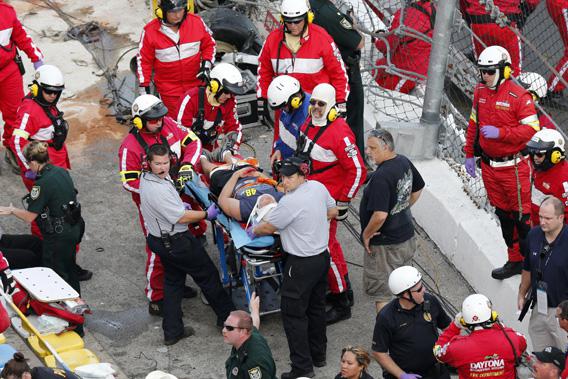Twenty-eight spectators were injured at the Daytona International Speedway on Saturday, the day before the Daytona 500, after a 12-car pileup sent a car into the stands. Is car racing the most dangerous sport for spectators?
No. Attending car races has its risks, but most people who die or suffer injuries at professional car races are drivers and field marshals. According to a study by the Charlotte Observer, 46 spectators died at motorsport events between 1990 and 2010, though none of these deaths occurred at a NASCAR race. A few NASCAR crashes have injured spectators, including a 1987 Talladega accident in which debris from Bobby Allison’s car flew into the grandstand and a 2009 Talladega accident in which Carl Edwards’ car flipped into the catch fence. The worst motorsport crash in history occurred at the 24-hour Grand Prix of Endurance and Efficiency in Le Mans in 1955; after 83 spectators died in that crash, better safety measures were adopted throughout motorsports.
The number of spectator deaths at racing events pales in comparison with the number of spectator deaths at soccer games. No comprehensive data on worldwide soccer injuries and deaths exists, but it’s clear that thousands of people have died at soccer games. Many of these deaths were a result of unsafe stadium conditions. For instance, in 1985, 56 people died in a fire at a soccer game in Bradford, England; the wooden Valley Parade stadium hadn’t been significantly updated in design since 1908, and litter had been allowed to build up under the stands. Many British and European stadiums also used to include terraces, or standing-room sections; after a crush that killed 96 people in Hillsborough Stadium in Sheffield, England, in 1989, England’s stadiums replaced terraces with seating areas to prevent dangerous overcrowding. Other soccer spectator deaths are a result of violence; last year, 79 people died in a riot following a soccer match at Port Said Stadium in Egypt.
Crowd violence is less of a problem at American sporting events (although behavior by Philadelphia Eagles fans became so rowdy in the 1990s that the city instituted an ad hoc court known as “Eagles Court” at Veterans Stadium in 1998). However, many American baseball and hockey fans have been injured or killed by balls and pucks. As of 2007, 61 baseball spectators had died after being hit by balls or bats (though most of these deaths occurred at amateur games), and 15 had died from falling from the stands. Only one spectator has been killed by a puck at an NHL game; in 2002, a 13-year-old girl died after being struck in the temple at a Columbus Blue Jackets game in Ohio. Following that incident, the NHL implemented netting over the end of each rink to prevent stray pucks from hitting spectators.
Got a question about today’s news? Ask the Explainer.
Explainer thanks Tim Ashwell of the University of New Hampshire; Richard O. Davies of the University of Nevada, Reno; and Dave Zirin of Edge of Sports.
